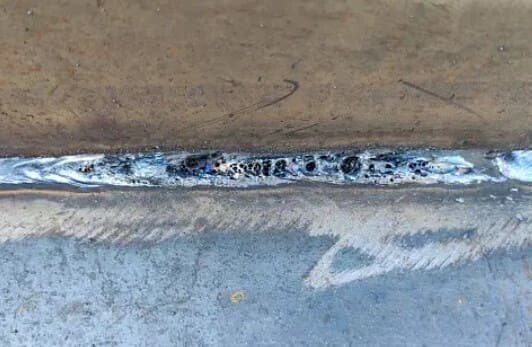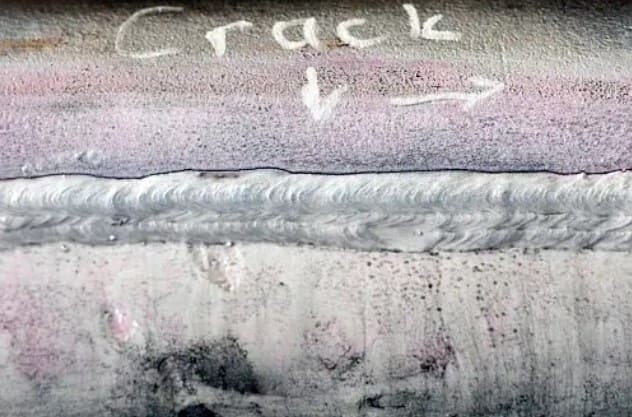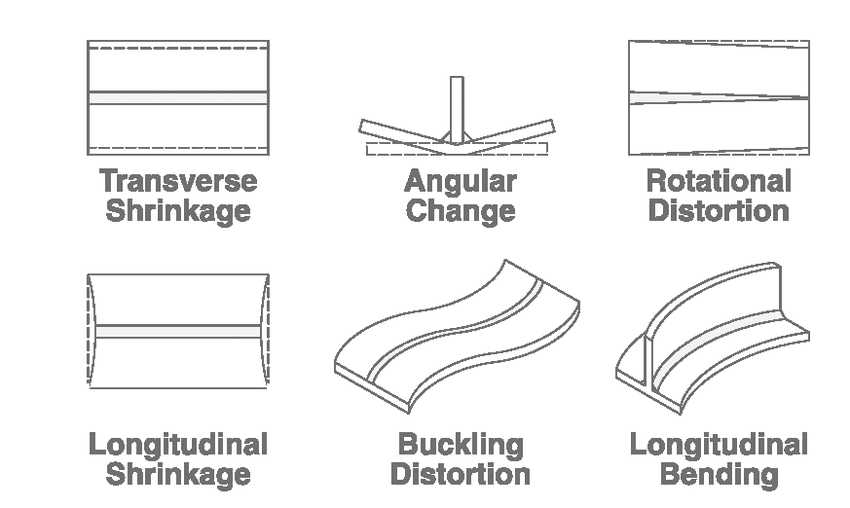Welding is a skillful and precise process that can produce strong and durable joints. However, welding can also encounter various problems that can affect the quality and performance of the welds. To avoid these problems, welders need to understand their causes and solutions. In this article, we will discuss the top 5 welding problems and how to solve them effectively.
I. Weld Porosity - Causes and Solutions
Weld porosity refers to small holes or voids within a weld joint. These voids can weaken the weld and reduce its overall integrity. There are several causes of weld porosity and various solutions can be implemented to minimize or eliminate it:

1) Moisture and Contamination:
Cause: Moisture or contaminants, such as oil, grease, rust, or paint, can vaporize during the welding process and form gas pockets within the weld.
Solution: Thoroughly clean the base metal before welding to remove any moisture, oil, or other contaminants. Use proper storage and handling techniques to prevent contamination.
2) Inadequate Shielding Gas:
Cause: Insufficient shielding gas coverage or improper gas flow can result in inadequate protection against atmospheric gases, leading to porosity.
Solution: Ensure the correct type and flow rate of shielding gas are used for the specific welding process. Regularly check gas cylinders and flow meters to ensure proper functioning.
3) Improper Welding Technique:
Cause: Welding too quickly, using excessive heat input, or improper travel speed can affect the weld pool's stability, causing gas entrapment.
Solution: Follow proper welding procedures, including recommended travel speed, heat input, and technique. Maintain a stable welding arc and monitor the weld pool to prevent excessive turbulence.
4) Electrode Moisture or Contamination (for Shielded Metal Arc Welding - SMAW):
Cause: Moisture or contaminants can be present in the electrode coating, leading to gas formation when the electrode is heated.
Solution: Store electrodes in a controlled environment and follow the manufacturer's recommendations for handling and drying. Preheat or bake electrodes as necessary to remove moisture before welding.
5) Insufficient Joint Preparation:
Cause: Poor joint design, inadequate bevel angles, or improper fit-up can result in inadequate gas escape paths and subsequent porosity.
Solution: Ensure proper joint preparation, including appropriate bevel angles, adequate root gap, and proper fit-up. Use back gouging or grinding as needed to create a sound joint.
6) Material-related Factors:
Cause: Certain materials, such as aluminum or some high-sulfur steels, are more prone to porosity due to their composition or surface conditions.
Solution: Select appropriate welding consumables, adjust welding parameters, or use pre-weld/post-weld treatments to address material-related porosity issues. Consult material specifications and welding guidelines.
It's important to note that the causes and solutions for weld porosity can vary depending on the welding process, base material, and specific application. Proper training, adherence to welding standards, and careful inspection can help identify and mitigate potential porosity issues.
II. Weld Cracking - Identifying and Resolving the Issue
Weld cracking is a common issue in welding that can compromise the strength and integrity of a weld joint. It can occur during or after the welding process. Here are some common types of weld cracking and their respective causes and resolutions:

1) Hot Cracking:
Causes: Hot cracking, also known as solidification cracking, typically occurs in the weld metal as it cools down. It is often caused by high levels of restraint, excessive heat input, or a metallurgical incompatibility between the base metal and filler material.
Solution: Use welding techniques that minimize restraint, such as proper joint design and the use of preheat or post-weld heat treatments. Select filler metals with improved crack resistance. Adjust welding parameters to control heat input and solidification rate.
2) Cold Cracking:
Cause: Cold cracking, also known as hydrogen-induced cracking or delayed cracking, appears in the heat-affected zone (HAZ) after the welding process. It is primarily caused by the presence of hydrogen in the weld joint, which can result from moisture, contaminants, or improper welding techniques.
Solution: Minimize hydrogen pickup by ensuring proper storage and handling of consumables, preheating the base metal, and using low-hydrogen electrodes or filler wires. Implement proper welding techniques to reduce the introduction of moisture or contaminants.
3) Stress Corrosion Cracking:
Cause: Stress corrosion cracking (SCC) can result from a variety of factors, including exposure to corrosive substances, improper material selection, or residual stresses in the weld joint.
Solution: Select materials with improved resistance to stress corrosion cracking. Minimize residual stresses through proper welding techniques, such as controlled cooling, stress relief, or post-weld heat treatments. Ensure proper environmental conditions to reduce exposure to corrosive substances.
4) Lamellar Tearing:
Cause: Lamellar tearing occurs parallel to the weld direction, typically in thick plates or structures with significant through-thickness tensile stress. It is caused by a combination of high welding-induced stress and susceptibility of the base metal to tearing due to its anisotropic properties.
Solution: Proper joint design and fit-up techniques can help reduce through-thickness stress. Use welding procedures that minimize distortion and employ techniques such as backstep welding or the addition of filler metal to alleviate stress concentration.
5) Crater Cracking:
Cause: Crater cracking refers to cracks that develop at the end of a weld bead or at weld termination points. It can occur due to high residual stresses, sudden cooling, or solidification shrinkage in the weld crater.
Solution: Employ crater-fill techniques such as backstepping or controlled termination to minimize stress concentration. Gradually reduce the welding current at the end of the weld to allow for proper solidification.
III. Lack of Fusion - Knowing and Overcoming the Challenge
Lack of fusion is a welding defect that occurs when there is an incomplete fusion between the weld metal and the base material or between different layers of weld metal. It can lead to weak or compromised weld joints. Here are some common causes and solutions for the lack of fusion:
1) Insufficient Heat Input:
Cause: Inadequate heat input during the welding process can prevent proper melting and fusion between the base material and the weld metal.
Solution: Increase the heat input by adjusting welding parameters such as current, voltage, or travel speed. Ensure that the base material reaches the required melting temperature for proper fusion.
2) Improper Joint Preparation:
Cause: Poor joint design or preparation, such as inadequate bevel angles, improper fit-up, or insufficient root gap, can impede proper fusion.
Solution: Ensure proper joint preparation, including appropriate bevel angles, root gaps, and fit-ups. Clean the joint surfaces to remove any contaminants that may hinder fusion.
3) Incorrect Electrode Angle or Position:
Cause: Incorrect electrode angle or improper positioning of the welding torch can result in poor fusion between the weld metal and the base material.
Solution: Maintain the correct electrode angle and torch position as specified for the welding process. Proper manipulation of the electrode or torch can ensure better heat transfer and fusion.
4) Insufficient Welding Technique:
Cause: Inadequate welding techniques, such as improper weaving or oscillation, can lead to a lack of fusion.
Solution: Follow recommended welding techniques for the specific process and joint configuration. Use proper weaving or oscillation patterns to ensure adequate heat coverage and fusion.
5) Insufficient Interpass Cleaning:
Cause: Failure to clean the weld bead or remove slag between multiple passes can prevent proper fusion during subsequent weld layers.
Solution: Clean the weld bead and remove slag between each pass using suitable methods like wire brushing, grinding, or slag removal tools. Ensure a clean surface before depositing the next weld layer.
6) Incorrect Filler Metal Selection:
Cause: The use of improper or incompatible filler metals can result in a lack of fusion due to differences in melting temperatures or metallurgical compatibility.
Solution: Select filler metals that are compatible with the base material and have appropriate melting temperatures for achieving proper fusion. Follow welding procedure specifications and consult material guidelines.
7) Insufficient Shielding Gas Coverage:
Cause: Inadequate shielding gas coverage or improper gas flow can lead to oxidation or contamination, preventing proper fusion.
Solution: Ensure proper shielding gas coverage and flow rates for the specific welding process. Monitor gas cylinders and flow meters to ensure consistent and adequate gas protection.
IV. Excessive Spatter - Minimizing the Mess
Excessive spatter refers to the excessive ejection of molten metal droplets during the welding process. Spatter can be messy, and wasteful, and may lead to poor weld quality if not addressed. Here are some common causes and strategies to minimize excessive spatter:
1) Incorrect Shielding Gas Flow or Composition:
Cause: Insufficient or excessive shielding gas flow, or using the wrong gas composition, can lead to excessive spatter.
Solution: Ensure the correct type of shielding gas is used for the welding process and select the appropriate flow rate based on the specific application. Consult welding procedure specifications and adjust the shielding gas flow accordingly.
2) Improper Wire Stickout:
Cause: Incorrect wire stickout, which is the distance between the contact tip and the workpiece, can contribute to the spatter.
Solution: Maintain the proper wire stick out by adjusting the wire feed speed and ensuring the wire extends beyond the contact tip by the recommended distance. Follow the welding equipment manufacturer's guidelines for the specific process and wire diameter.
3) Incorrect Voltage or Amperage Settings:
Cause: Incorrect voltage or amperage settings can result in excessive spatter.
Solution: Adjust the voltage and amperage settings based on the welding process, joint configuration, and material thickness. Follow the recommended settings provided in welding procedure specifications or consult welding experts for guidance.
4) Contaminated Base Metal or Filler Wire:
Cause: Contaminated base metal or filler wire can contribute to spatter formation during welding.
Solution: Thoroughly clean the base metal before welding to remove any contaminants such as oil, grease, rust, or paint. Ensure that the filler wire is clean.
5) Incorrect Gun or Torch Angle:
Cause: Improper gun or torch angle can affect the shielding gas coverage and lead to spatter.
Solution: Maintain the correct gun or torch angle for the specific welding process. Refer to welding procedure specifications or consult welding experts for the recommended angle to ensure proper gas coverage and minimize spatter.
6) Poor Wire Quality or Improper Wire Feed:
Cause: Low-quality welding wire or improper wire feed can contribute to spatter formation.
Solution: Use high-quality welding wire that is appropriate for the specific welding process and base material. Ensure the wire feed mechanism is properly adjusted, and the wire spool is positioned correctly to provide consistent and smooth wire feeding.
7) Inadequate Joint Preparation:
Cause: Poor joint design or inadequate joint preparation.
Solution: Ensure proper joint preparation, including appropriate bevel angles, root gaps, and fit-up. Clean the joint surfaces and remove any contaminants or surface oxides before welding to promote better fusion and reduce spatter.
Related article: 10 Secrets to Reduce Welding Spatter
V. Welding Distortion - Managing and Controlling Deformations
Distortion (or weld-induced deformation) refers to the changes in shape or dimension of a welded structure caused by the heating and cooling cycles during welding. Managing and controlling distortions is important to ensure that the welded components or structures meet the required dimensional tolerances and maintain their intended functionality. Here are some strategies to manage and control distortions:

1) Proper Joint Design:
Use appropriate joint design and welding sequences to minimize distortion. Consider techniques such as symmetrical welding or balanced welding to distribute the heat evenly and reduce the overall distortion.
2) Fixturing and Clamping:
Use proper fixturing and clamping techniques to secure the workpiece during welding. Fixtures can help to constrain and control the movement of the workpiece, minimizing distortion. Welding jigs, fixtures, or temporary tack welds can provide stability and control.
3) Preheating and Post-weld Heat Treatment:
Preheating the base metal before welding can help reduce the temperature gradient and subsequent distortion. It helps to minimize the difference in thermal expansion and contraction between the weld and the surrounding material. Post-weld heat treatment, such as stress relief annealing, can also be applied to relieve residual stresses and minimize distortion.
4) Welding Sequence and Technique:
Adopt welding sequences that balance the heat input and minimize the buildup of residual stresses. Start welding from the center and move outwards or use backstep welding techniques to control distortion. Employ techniques such as intermittent welding, skip welding, or stitch welding to allow for localized cooling and stress relief.
5) Welding Process Selection:
Consider using welding processes that inherently generate less heat and have lower distortion potential. For example, processes like laser welding or electron beam welding provide precise and localized heat input, reducing distortion compared to processes like shielded metal arc welding (SMAW) or gas metal arc welding (GMAW).
6) Welding Parameters:
Optimize welding parameters such as heat input, travel speed, and welding current to control the heat input and minimize distortion. Using lower heat input and faster travel speed can help reduce the overall heating and cooling cycles, thereby minimizing distortion.
7) Back Purging or Backstep Welding:
In certain applications, using back purging or backstep welding techniques can help control distortion. Back purging involves introducing inert gas to the backside of the weld joint to prevent oxidation and reduce distortion. Backstep welding involves welding in a reverse direction to relieve stresses and minimize distortion.
8) Minimizing Weld Volume:
Reduce the weld volume by using appropriate joint preparations, such as narrow groove welds, or using higher-strength filler metals. Minimizing the weld volume reduces the amount of material undergoing thermal expansion and contraction, thus minimizing distortion.
By understanding the top five welding problems and implementing practical solutions, welders can overcome common challenges and achieve high-quality welds in 2023. To optimize their welding processes, welders need to address porosity, cracking, lack of fusion, spatter, and distortion through appropriate techniques, parameter adjustments, and material preparation. To learn more welding tips or guides, you can collect Megmeet News Center Page or follow our LinkedIn page. As welding technology is updated, you can see the latest article Welding Defects, Problems And Easy Solutions [2023].
Related articles:
1. How to Solve 10 Common TIG Welding Problems [Guide]
2. 9 Maintenance Problems that Cause Bad Welds
3. Welding Defects, Problems And Easy Solutions [2023]
4. How to Identify the 7 Most Dangerous Welding Defects?
5. Undercut Welding Defect: Causes, Prevention, and Repair






